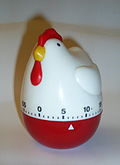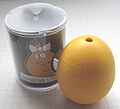
Cooking, also known as cookery or professionally as the culinary arts, is the art, science and craft of using heat to make food more palatable, digestible, nutritious, or safe. Cooking techniques and ingredients vary widely, from grilling food over an open fire, to using electric stoves, to baking in various types of ovens, reflecting local conditions. Cooking is an aspect of all human societies and a cultural universal.

Boiling or ebullition is the rapid phase transition from liquid to gas or vapor; the reverse of boiling is condensation. Boiling occurs when a liquid is heated to its boiling point, so that the vapour pressure of the liquid is equal to the pressure exerted on the liquid by the surrounding atmosphere. Boiling and evaporation are the two main forms of liquid vapourization.

Poaching is a cooking technique that involves heating food submerged in a liquid, such as water, milk, stock or wine. Poaching is differentiated from the other "moist heat" cooking methods, such as simmering and boiling, in that it uses a relatively lower temperature. This temperature range makes it particularly suitable for delicate food, such as eggs, poultry, fish and fruit, which might easily fall apart or dry out using other cooking methods. Poaching is often considered a healthy cooking method because it does not use fat for cooking or flavoring the food.
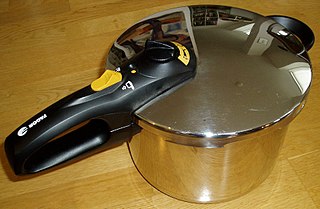
Pressure cooking is the process of cooking food under high pressure steam and water or a water-based cooking liquid, in a sealed vessel known as a pressure cooker. High pressure limits boiling and creates higher cooking temperatures which cook food far more quickly than at normal pressure.
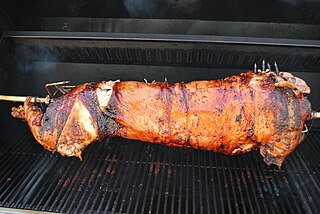
Roasting is a cooking method that uses dry heat where hot air covers the food, cooking it evenly on all sides with temperatures of at least 150 °C (300 °F) from an open flame, oven, or other heat source. Roasting can enhance the flavor through caramelization and Maillard browning on the surface of the food. Roasting uses indirect, diffused heat, and is suitable for slower cooking of meat in a larger, whole piece. Meats and most root and bulb vegetables can be roasted. Any piece of meat, especially red meat, that has been cooked in this fashion is called a roast. Meats and vegetables prepared in this way are described as "roasted", e.g., roasted chicken or roasted squash.

A microwave oven or simply microwave is an electric oven that heats and cooks food by exposing it to electromagnetic radiation in the microwave frequency range. This induces polar molecules in the food to rotate and produce thermal energy in a process known as dielectric heating. Microwave ovens heat foods quickly and efficiently because excitation is fairly uniform in the outer 25–38 mm(1–1.5 inches) of a homogeneous, high-water-content food item.

In cooking, to coddle food is to heat it in water kept just below the boiling point. In the past, recipes called for coddling fruit, but in recent times the term is usually only applied to coddled eggs. Coddling differs from poaching in that the coddled ingredient is not placed directly in hot water, but instead in a small dish placed in a hot water bath. The process is either done in a regular pan or pot filled with water, either on the stovetop or placed in the oven, or through the use of a special device such as an "egg coddler". The oven technique is similar to the preparation of baked eggs, the difference being that the preparation of baked eggs does not have to employ a water bath.

Cookware and bakeware is food preparation equipment, such as cooking pots, pans, baking sheets etc. used in kitchens. Cookware is used on a stove or range cooktop, while bakeware is used in an oven. Some utensils are considered both cookware and bakeware.

A rice cooker or rice steamer is an automated kitchen appliance designed to boil or steam rice. It consists of a heat source, a cooking bowl, and a thermostat. The thermostat measures the temperature of the cooking bowl and controls the heat. Complex, high-tech rice cookers may have more sensors and other components, and may be multipurpose.

An oven is a tool which is used to expose materials to a hot environment. Ovens contain a hollow chamber and provide a means of heating the chamber in a controlled way. In use since antiquity, they have been used to accomplish a wide variety of tasks requiring controlled heating. Because they are used for a variety of purposes, there are many different types of ovens. These types differ depending on their intended purpose and based upon how they generate heat.

A slow cooker, also known as a crock-pot, is a countertop electrical cooking appliance used to simmer at a lower temperature than other cooking methods, such as baking, boiling, and frying. This facilitates unattended cooking for many hours of dishes that would otherwise be boiled: pot roast, soups, stews and other dishes.

A solar cooker is a device which uses the energy of direct sunlight to heat, cook or pasteurize drink and other food materials. Many solar cookers currently in use are relatively inexpensive, low-tech devices, although some are as powerful or as expensive as traditional stoves, and advanced, large scale solar cookers can cook for hundreds of people. Because they use no fuel and cost nothing to operate, many nonprofit organizations are promoting their use worldwide in order to help reduce fuel costs and air pollution, and to help slow down deforestation and desertification.

Sous vide, also known as low-temperature, long-time (LTLT) cooking, is a method of cooking invented by the French chef Georges Pralus in 1974, in which food is placed in a plastic pouch or a glass jar and cooked in a water bath for longer than usual cooking times at a precisely regulated temperature.

Boiled eggs are eggs, typically from a chicken, cooked with their shells unbroken, usually by immersion in boiling water. Hard-boiled eggs are cooked so that the egg white and egg yolk both solidify, while soft-boiled eggs may leave the yolk, and sometimes the white, at least partially liquid and raw. Boiled eggs are a popular breakfast food around the world.

A poached egg is an egg that has been cooked, outside the shell, by poaching, as opposed to simmering or boiling. This method of preparation can yield more delicately cooked eggs than cooking at higher temperatures such as with boiling water. Poached eggs can be served in several dishes.

A kitchen utensil is a small hand-held tool used for food preparation. Common kitchen tasks include cutting food items to size, heating food on an open fire or on a stove, baking, grinding, mixing, blending, and measuring; different utensils are made for each task. A general purpose utensil such as a chef's knife may be used for a variety of foods; other kitchen utensils are highly specialized and may be used only in connection with preparation of a particular type of food, such as an egg separator or an apple corer. Some specialized utensils are used when an operation is to be repeated many times, or when the cook has limited dexterity or mobility. The number of utensils in a household kitchen varies with time and the style of cooking.

A thermal cooker, or a vacuum flask cooker, is a cooking device that uses thermal insulation to retain heat and cook food without the continuous use of fuel or other heat source. It is a modern implementation of a haybox, which uses hay or straw to insulate a cooking pot.

A multicooker is an electric kitchen appliance for automated cooking using a timer. A typical multicooker is able to boil, simmer, bake, fry, deep fry, grill roast, stew, steam and brown food.
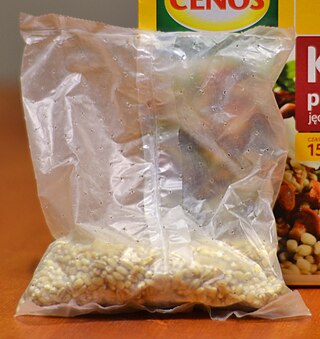
Boil-in-bags are a form of packaged food products in which bagged food is heated or cooked in boiling water. Plastic bags can be solid and impermeable for holding frozen foods; alternatively, bags can be porous or perforated to allow boiling water into the bag.


